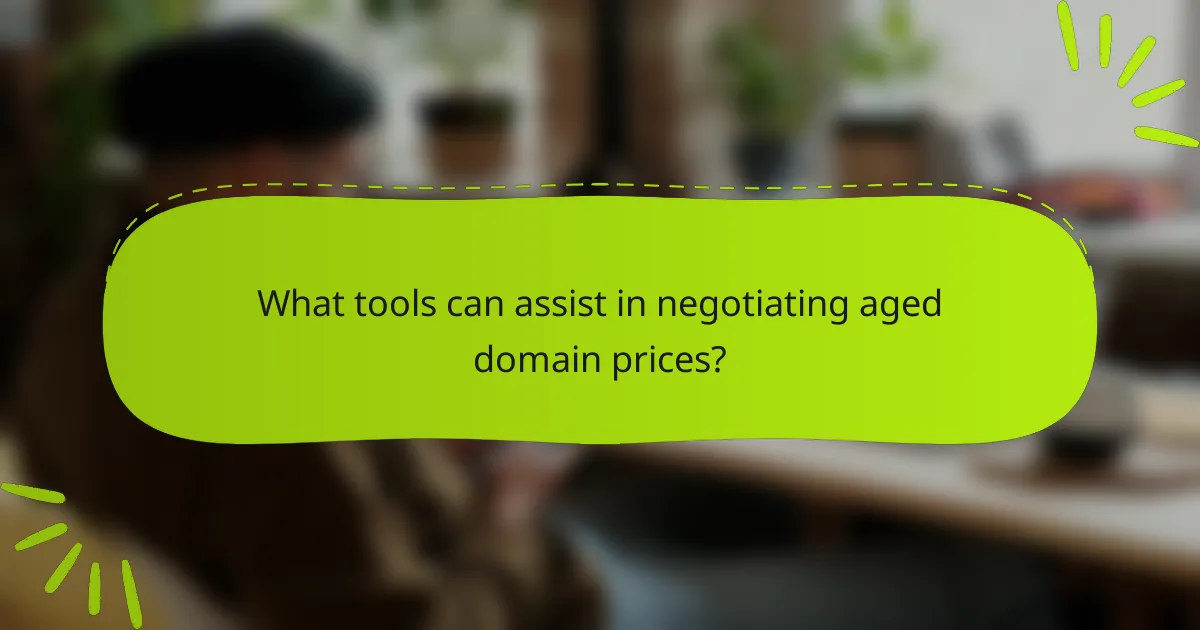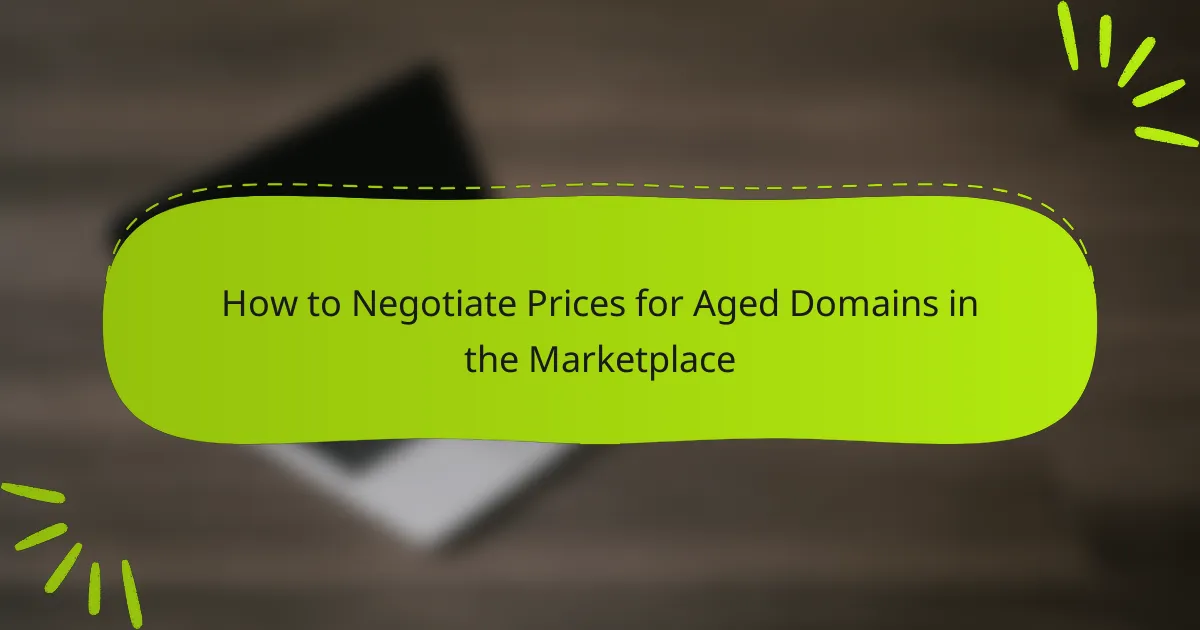Negotiating prices for aged domains requires a keen understanding of market dynamics and the motivations of sellers. By grasping the key factors that influence domain value, buyers can employ effective strategies to secure advantageous deals. Building relationships and presenting competitive offers can further enhance negotiation outcomes, leading to successful transactions in the marketplace.

How can you negotiate prices for aged domains in the Pacific Islands?
Negotiating prices for aged domains in the Pacific Islands involves understanding the market dynamics and the seller’s motivations. By employing effective negotiation tactics, you can secure a favorable deal that reflects the domain’s true value.
Research market value
Start by researching the market value of aged domains similar to the one you are interested in. Use online tools and marketplaces to gauge average prices, which can typically range from a few hundred to several thousand USD, depending on factors like domain length, keyword relevance, and existing traffic.
Consider checking recent sales data for comparable domains to establish a baseline for your negotiations. Websites like NameBio provide historical sales information that can help you understand current trends and pricing standards.
Understand seller motivations
Understanding the seller’s motivations can significantly influence your negotiation strategy. Sellers may be motivated by various factors, such as the need for quick cash, a desire to offload unused assets, or the potential for future investments.
Engage the seller in conversation to uncover their reasons for selling. This insight can help you tailor your offer and potentially create a win-win situation that addresses their needs while still achieving a fair price for you.
Utilize negotiation tactics
Effective negotiation tactics can enhance your chances of securing a better price for the aged domain. Start with a reasonable initial offer that reflects your research on market value, and be prepared to justify your offer with data.
Employ tactics such as anchoring, where you set a reference point with your initial offer, and be willing to walk away if the price exceeds your budget. Additionally, consider offering non-monetary incentives, such as a quick closing or flexible payment terms, to sweeten the deal for the seller.

What factors influence aged domain pricing?
Aged domain pricing is influenced by several key factors that determine its value in the marketplace. Understanding these elements can help buyers negotiate better prices and make informed decisions.
Domain authority and backlinks
Domain authority is a crucial metric that reflects the credibility and strength of a domain based on its backlink profile. Aged domains with high domain authority often have numerous quality backlinks from reputable sites, which can significantly increase their market value.
When negotiating, assess the quality of backlinks and the overall authority score using tools like Moz or Ahrefs. A domain with a strong backlink profile can command a higher price, so be prepared to justify your offer based on these metrics.
Keyword relevance and traffic
Keyword relevance refers to how well the domain aligns with specific search terms that potential visitors might use. Aged domains that rank for high-traffic keywords can be more valuable, as they have the potential to drive significant organic traffic.
Evaluate the domain’s existing traffic using tools like Google Analytics or SEMrush. If the domain has a history of attracting visitors, it can justify a higher asking price. Conversely, if the keywords are not relevant to your intended use, consider negotiating down based on this factor.
Historical sales data
Historical sales data provides insights into what similar aged domains have sold for in the past. This information can serve as a benchmark during negotiations, helping you understand the market trends and pricing standards.
Research platforms like GoDaddy Auctions or NameBio to find comparable sales. If you find that similar domains have sold for lower prices, use this data to support your negotiation strategy and aim for a fairer deal.

What strategies can improve negotiation outcomes?
Improving negotiation outcomes for aged domains involves building relationships, offering flexible payment methods, and presenting competitive offers. These strategies can create a more favorable environment for both parties, leading to successful transactions.
Build rapport with sellers
Establishing a connection with sellers is crucial in negotiations. Take the time to understand their motivations for selling and share your own interest in the domain. This mutual understanding can foster trust and make the seller more amenable to your offers.
Engage in friendly conversation and show genuine interest in their perspective. A positive relationship can lead to more open discussions and potentially better pricing. Remember, people are more likely to negotiate favorably with someone they feel comfortable with.
Offer flexible payment options
Providing various payment options can make your offer more attractive to sellers. Consider proposing installment payments, escrow services, or even trade options if applicable. Flexibility can alleviate seller concerns about immediate cash flow, making them more willing to negotiate.
For instance, if a seller is hesitant about a lower upfront payment, suggesting a structured payment plan might ease their worries. Always clarify the terms and ensure both parties are comfortable with the arrangement to avoid misunderstandings.
Present competitive offers
To stand out in negotiations, your offers should reflect the market value of the domain. Research similar sales to determine a reasonable price range and present your offer accordingly. This shows the seller that you are informed and serious about the purchase.
Additionally, consider including incentives, such as a quick closing or a higher initial payment, to sweeten the deal. Competitive offers not only demonstrate your commitment but also encourage sellers to consider your proposal over others they may receive.

What are common pitfalls in domain price negotiations?
Common pitfalls in domain price negotiations include overvaluing the domain, ignoring the seller’s emotional attachment, and failing to conduct due diligence. Recognizing these issues can help you negotiate more effectively and avoid costly mistakes.
Overvaluing the domain
Overvaluing a domain can lead to unrealistic expectations during negotiations. Sellers may inflate the price based on personal beliefs about the domain’s worth rather than market realities. It’s crucial to research comparable sales and current market trends to establish a fair valuation.
Consider using online appraisal tools or consulting with domain experts to get an objective assessment. A well-researched price range can help you negotiate confidently without overstepping budget limits.
Ignoring seller’s emotional attachment
Sellers often have emotional ties to their domains, which can influence their pricing. This attachment may stem from personal experiences or the domain’s history, making them less willing to negotiate. Acknowledging this emotional aspect can create a more empathetic negotiation environment.
To navigate this, approach discussions with sensitivity. Ask the seller about their connection to the domain and express appreciation for its value. This can help build rapport and potentially lead to a more favorable price.
Failing to conduct due diligence
Conducting due diligence is essential in domain negotiations to avoid unexpected issues. This includes checking the domain’s history, traffic statistics, and any existing trademarks. Failing to do so can result in overpaying or acquiring a domain with legal complications.
Utilize tools like WHOIS lookup and domain history checkers to gather critical information. A thorough analysis will empower you to make informed decisions and negotiate from a position of strength.

How to assess the potential ROI of an aged domain?
Assessing the potential ROI of an aged domain involves evaluating its traffic, monetization possibilities, and SEO advantages. Understanding these factors helps determine if the investment aligns with your business goals.
Analyze traffic trends
Start by examining the historical traffic data of the aged domain. Tools like Google Analytics or SEMrush can provide insights into visitor numbers, sources, and engagement levels over time. Look for consistent traffic patterns, as spikes may indicate temporary interest rather than sustained value.
Consider the domain’s traffic sources, such as organic search, direct visits, or referrals. A balanced mix of traffic sources is generally more reliable, while heavy reliance on one source can be risky.
Evaluate monetization options
Explore various monetization strategies for the domain, such as affiliate marketing, ad placements, or selling products. The best approach depends on the domain’s niche and audience. For instance, a domain in the tech sector may perform well with affiliate links to gadgets.
Estimate potential earnings based on industry benchmarks. For example, affiliate commissions can range from 5% to 50% depending on the products sold. This helps in calculating a rough ROI based on expected traffic and conversion rates.
Consider SEO benefits
Assess the SEO profile of the aged domain, including its backlink profile, domain authority, and keyword rankings. A strong backlink profile can enhance your site’s credibility and improve search engine rankings, which translates to more organic traffic.
Evaluate the relevance of existing backlinks and the potential for future SEO growth. Domains with established authority in a specific niche can provide a significant advantage, making them more valuable for long-term investments.

What tools can assist in negotiating aged domain prices?
Several tools can greatly enhance your ability to negotiate prices for aged domains by providing critical data on keywords, backlinks, and valuations. Utilizing these resources can help you make informed decisions and justify your offers during negotiations.
SEMrush for keyword analysis
SEMrush is a powerful tool for analyzing keywords associated with an aged domain. By examining search volume, keyword difficulty, and competition, you can gauge the potential traffic the domain could generate. This information is crucial when negotiating, as it allows you to present a data-driven argument for your price point.
When using SEMrush, focus on high-value keywords that align with your intended use for the domain. If the domain has strong keyword rankings, it may justify a higher price. Conversely, if the keywords are low in value, you can leverage this to negotiate a lower price.
Ahrefs for backlink checks
Ahrefs is essential for assessing the backlink profile of an aged domain. A strong backlink profile can significantly enhance a domain’s value, as it indicates authority and potential for SEO benefits. Check metrics like Domain Rating (DR) and the number of referring domains to understand the domain’s standing in search engine results.
While negotiating, highlight the quality and relevance of backlinks. If the domain has backlinks from reputable sites, it can justify a higher asking price. On the other hand, if the backlinks are spammy or irrelevant, you can argue for a reduced price based on potential SEO risks.
Estibot for valuation estimates
Estibot provides automated valuation estimates for domains based on various factors, including keyword data, traffic, and market trends. This tool can serve as a benchmark during negotiations, helping you to understand the fair market value of the aged domain you are interested in.
When using Estibot, consider its valuation alongside your own research. If the estimate aligns with your findings from SEMrush and Ahrefs, it can strengthen your negotiation position. However, if there is a significant discrepancy, be prepared to justify your price with supporting data from your analysis.
